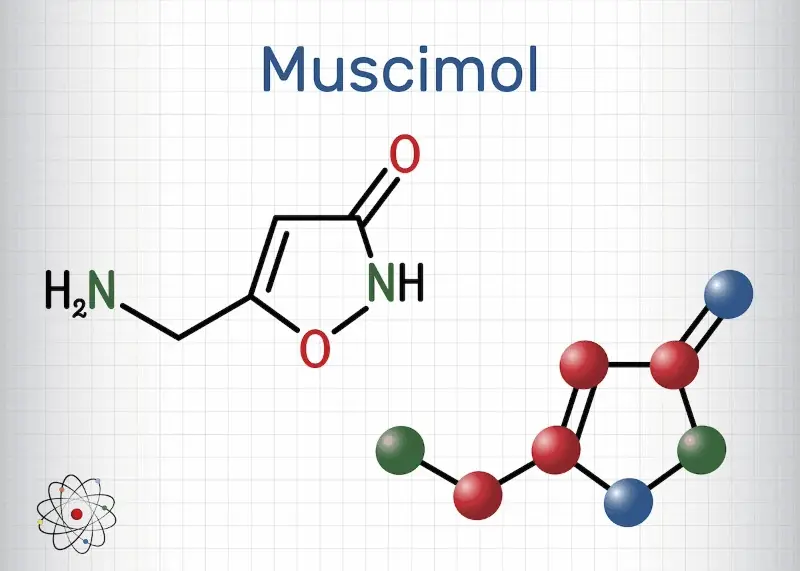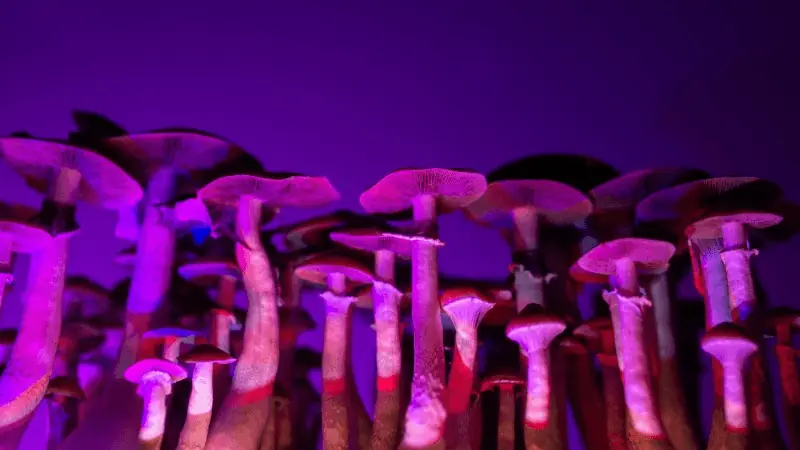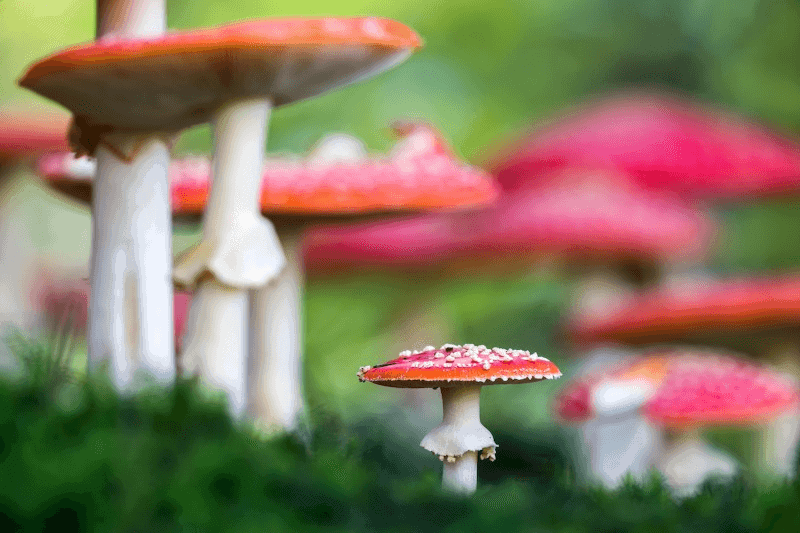Table of Contents
Muscimol, a potent psychoactive compound found in Amanita muscaria mushrooms, has intrigued researchers and enthusiasts alike with its unique effects on the human brain, leading to numerous studies on its chemical profiles among psychoactive drugs and chemicals. This substance, found in drugs like magic mushrooms and certain chemicals, acts on GABA receptors, leading to an altered state of consciousness characterized by vivid hallucinations, profound changes in perception, and analgesic effects. While its usage spans centuries in various cultural rituals, modern science, through studies, seeks to understand muscimol’s potential therapeutic benefits amidst concerns over its potency, safety, and efficacy as a drug found in magic mushrooms. As we delve into the complexities of this fascinating compound, magic mushrooms, it’s critical to approach with both curiosity and caution, recognizing the fine line between traditional use and scientific exploration, including the study of their chemicals and chemical profiles.
Key Takeaways
- Muscimol, a psychoactive compound found in Amanita mushrooms, has a significant impact on the brain, altering perception and potentially offering therapeutic benefits.
- Its effects range from mild euphoria to profound hallucinations, underlining the importance of understanding its potency and the variability of individual reactions.
- Despite potential benefits in areas like neurology and psychiatry, muscimol’s side effects and toxicity levels necessitate caution, emphasizing the need for proper dosage and medical supervision.
- The legal status of muscimol varies globally, reflecting its complex safety profile and potential for misuse, making it crucial for individuals to stay informed about regulations in their region.
- Comparisons with other psychoactive substances highlight muscimol’s unique properties but also underscore the importance of considering safer alternatives or treatments, especially for therapeutic use.
- Understanding muscimol’s historical context enriches our appreciation of its role in culture and medicine, while ongoing research into its effects and applications points toward future directions in psychedelic science.
Understanding Muscimol

Chemical Structure
Muscimol is a unique psychoactive substance. It comes from some mushrooms. Its structure sets it apart from other psychoactive compounds. This difference lies in its chemical makeup.
The core of muscimol’s structure, found in magic mushrooms, involves a five-membered ring that interacts with the receptor in cells. This ring has a hydrogen atom bonded to nitrogen. Such details, including neurons, studies, cells, and receptor, are crucial for its activity within the human brain.
Natural Sources
Amanita Mushrooms
Amanita mushrooms are where muscimol primarily comes from. Notable types include Amanita muscaria and Amanita pantherina. These mushrooms have red caps with white spots, making them easy to identify.
These fungi stand as the main natural source of muscimol, a chemical in certain drugs. Their distinctive appearance, often depicted in articles, signs, clothing, and art, has been known for centuries, often depicted in folklore and art.
Mechanism of Action
GABA Receptors
Muscimol targets GABA(A) receptors in the brain as an agonist. This action boosts inhibitory neurotransmission across neural pathways.
It affects receptor subtypes differently, changing how neurons communicate with each other through chemicals and agonist effect. This variance in interaction, as studies suggest, can lead to diverse effects on brain function, perception, and exposure-induced heterogeneity and bias.
Brain Impact
By enhancing GABAergic activity, muscimol, a GABA receptor agonist, can sedate or depress central nervous system functions. This may result in altered states of consciousness ranging from mild relaxation to profound hallucinations depending on dosage levels, with effects on pain and thermal hyperalgesia.
At higher doses, users might experience euphoria or vivid hallucinations due to these chemical changes, including the effect of thermal hyperalgesia and pain. Such effects underscore the potent impact muscimol and other chemicals can have on mental processes, pain, and sensory experiences, according to studies and analysis.
Muscimol Effects

Psychotropic Effects
Muscimol is known for its psychotropic effects. It can induce altered states of consciousness, visual hallucinations, and effects such as thermal hyperalgesia and mechanical hyperalgesia. These effects are not uniform across all users. They vary widely from one individual to another. This variability makes muscimol a chemical substance of interest in studies and analysis of brain function, perception, and effect.
Some people compare muscimol’s chemical effects to those of LSD or psilocybin, based on studies and analysis. However, there are distinct differences between them. While all three can alter perceptions and thoughts, muscimol operates through unique pathways in the brain, affecting neurons and chemical effects without influencing pain. It specifically targets GABA receptors in neurons, which play a crucial role in inhibitory neurotransmission, affecting chemical signals related to pain.
Therapeutic Potential
Neuropathic Pain
Studies have explored the chemical muscimol’s potential therapeutic effects on chronic pain conditions, particularly neuropathic pain, by targeting neurons associated with thermal hyperalgesia. By acting on the neurons in the central nervous system through administration, it modulates the effect on how pain and thermal hyperalgesia are perceived. This action suggests that muscimol, a chemical, could significantly reduce symptoms associated with neuropathic pain, including thermal hyperalgesia, by affecting neurons.
Studies indicate that its administration effectively changes the way the brain processes pain signals, leading to adaptation and possibly hyperalgesia, according to analysis. This finding opens up new avenues for treating chronic pain without relying on traditional medications such as opioids, potentially reducing hyperalgesia and the effect of opioid administration, studies suggest.
Hyperalgesia Treatment
Hyperalgesia, an enhanced sensitivity to pain, might also be managed with muscimol, as studies and analysis of its effect indicate. It normalizes pain thresholds and reduces hyperalgesia by interacting with GABA receptors involved in modulating discomfort, studies show following administration. This interaction, as studies on hyperalgesia suggest, points towards a promising non-opioid pathway for managing persistent pain conditions through SMD administration.
The capacity of muscimol to mitigate hyperalgesia and pain highlights its potential as an innovative treatment option, supported by studies on its administration. Its efficacy stems from its ability to recalibrate disrupted neural circuits responsible for exaggerated pain responses in hyperalgesia.
Muscimol in Amanita Mushrooms

Amount Variation
Muscimol concentrations vary greatly between individual Amanita mushrooms. This variability poses a challenge for those attempting to estimate dosages accurately for pain management, particularly in conditions of hyperalgesia. Environmental factors such as soil composition, climate, and the age of the mushroom significantly influence muscimol content.
One mushroom might contain a high level of muscimol while another, growing just a few feet away, has much less. This makes it difficult for researchers and enthusiasts alike to predict pain effects and hyperalgesia accurately. The natural variability underscores the importance of caution when dealing with these mushrooms, pain, and hyperalgesia.
Isolation Process
Chemical Synthesis
Chemical synthesis offers a controlled way to produce muscimol. It involves using gamma-amino acids as precursor molecules. These synthetic pathways enable scientists to create muscimol without relying on natural sources.
Laboratory synthesis not only ensures a consistent supply but also opens doors for detailed research into potential pharmaceutical applications of muscimol, including pain and hyperalgesia. By understanding how this compound interacts with the brain, researchers can explore new treatments for neurological conditions, including pain and hyperalgesia.
Muscimol’s Brain Impact

GABAergic Mechanisms
Muscimol acts by mimicking the natural neurotransmitter GABA. This action leads to an inhibitory effect on neurons. It essentially calms the brain’s activity. By doing so, muscimol shifts the balance towards inhibition over excitation in neural circuits, reducing pain and hyperalgesia.
This shift plays a key role in controlling anxiety, stress responses, and hyperalgesia. The body needs both excitatory and inhibitory signals for normal function. Muscimol increases the inhibitory signals, which can help manage conditions related to excessive neural excitement, including hyperalgesia.
For example, people with anxiety disorders may have an imbalance favoring excitation in their brains. Muscimol’s ability to mimic GABA means it could potentially restore some of this lost balance. However, its use must be carefully controlled due to its potent effects, including hyperalgesia.
Control of Posture
Substantia Nigra Role
Muscimol influences dopamine release by acting on GABA receptors found in the substantia nigra. This area of the brain is crucial for motor control and reward mechanisms.
The modulation of this area has implications for disorders involving dopaminergic systems such as Parkinson’s disease (PD). In PD, there is a loss of dopamine-producing neurons leading to motor control issues among other symptoms.
By targeting GABA receptors within the substantia nigra, muscimol could offer new avenues for treatment strategies aimed at managing symptoms or slowing progression of diseases like PD.
Since this region also plays a part in reward mechanisms, understanding how muscimol affects it could lead to insights into addiction and motivational disorders.
Benefits and Therapeutic Uses
Microdosing Effects
Microdosing has emerged as a fascinating area of study, especially with compounds like muscimol. Sub-threshold doses of muscimol may offer significant benefits without inducing the full spectrum of psychotropic effects typically associated with higher doses. This approach can potentially improve mood and spark creativity, making it an attractive option for those seeking mental health solutions or cognitive enhancement.
The practice has garnered growing interest for its potential in treating various psychological conditions and enhancing brain function. However, the scientific community calls for more research to fully understand the long-term impacts of microdosing muscimol. Questions about optimal dosing strategies also remain unanswered.
Current Discoveries
Herbal Biomolecules
Muscimol is not alone in its therapeutic journey; it’s part of a larger family of bioactive compounds found in psychoactive herbs and fungi. These substances often work better together than they do separately due to their synergistic effects. For instance, when combined with other molecules, muscimol’s impact on the brain might be enhanced or modified, offering new avenues for treatment.
Understanding how these interactions work is crucial for unlocking potential therapeutic benefits. Researchers are delving into this synergy to develop treatments that could aid various conditions without causing harmful side effects.
Side Effects and Toxicity
Toxicokinetics
Muscimol exhibits rapid absorption from the gastrointestinal tract after ingestion. This quick uptake into the system means that peak plasma concentrations can occur within an hour. Understanding this is crucial because it directly influences how quickly symptoms may appear post-ingestion.
The body primarily excretes muscimol unchanged in urine. This mode of elimination plays a significant role in determining the duration of its effects on the body. The faster it’s removed, the shorter its impact lasts.
Safety Concerns
Toxicity Mechanism
Muscimol acts by overstimulating GABA(A) receptors in the brain. At low doses, this action contributes to its therapeutic benefits discussed earlier. However, at high doses, it can lead to neurotoxic effects due to excessive receptor activation.
Symptoms of toxicity range widely depending on dose and individual susceptibility:
- Mild cases might experience drowsiness or confusion.
- Severe reactions could include seizures or coma.
Understanding these risks is vital for safely leveraging muscimol’s potential benefits.
Legal Status and Safety Concerns

Legality Overview
The legal status of muscimol varies across the globe. Some countries have strict regulations due to its potential for abuse and poisoning incidents. In many places, possession and sale are allowed when muscimol occurs naturally in mushrooms. However, synthetic forms might be controlled substances.
Countries regulate this compound differently. In the United States, for instance, there is no specific legislation targeting natural sources of muscimol-containing mushrooms. This means they fall into a gray area under federal law according to the records administration at Whitehouse Station.
Conversely, some European nations have stricter laws. They control both natural and synthetic forms of muscimol because of health concerns.
Safety Guidelines
Microdosing Safety
Microdosing involves taking small amounts of a substance to achieve health benefits without intoxicating effects. With muscimol, microdosing has risks due to unpredictable psychological impacts and possible physiological dependence with regular use.
Experts recommend caution with microdosing muscimol because comprehensive studies on its long-term safety profile are lacking.
- Unpredictable psychological effects can range from mild euphoria to severe anxiety or hallucinations.
- Physiological dependence could develop with frequent use over time.
To minimize risks:
- Always start with very low doses if trying microdosing.
- Monitor your reactions closely.
- Seek professional advice before starting any regimen involving psychoactive substances.
Given these factors, it’s crucial for individuals considering using muscimol—whether through microdosing or otherwise—to understand their local laws thoroughly and approach usage cautiously.
Comparisons and Alternatives
Muscimol vs Psilocybin
Muscimol and psilocybin have distinct chemical structures. This difference leads to varied mechanisms of action within the brain. Both can cause hallucinations, but their effects diverge beyond this similarity.
Psilocybin acts primarily on serotonin receptors. It is known for its psychedelic effects which include altered perception and mood changes. On the other hand, muscimol targets GABAA receptors. It produces sedative and hypnotic effects alongside hallucinations.
Studies show that muscimol’s interaction with GABAA receptors can lead to a calming effect not seen with psilocybin. This makes each substance suitable for different types of research or therapeutic applications.
Psychedelic Substance Debate
GABAA Agonists Connection
Muscimol shares pharmacological properties with other GABAA receptor agonists used in clinical settings for anxiety and epilepsy treatment.
These substances, including benzodiazepines, work by enhancing the inhibitory neurotransmitter GABA’s effect in the brain. They help regulate nervous system excitability, offering relief from symptoms of anxiety disorders or controlling epileptic seizures.
The debate around psychedelic substances often includes discussions on their potential therapeutic benefits versus risks associated with misuse or abuse.
Muscimol’s connection to clinically used GABAA agonists highlights its potential as a therapeutic agent under controlled conditions.
Historical Context and Future Directions
Amanita Muscaria History
Amanita muscaria, commonly known as the fly agaric mushroom, has a vibrant history. Cultures around the world have used it for centuries. These uses range from religious rituals to shamanic journeys. Its psychoactive properties were not merely stumbled upon but deeply integrated into various traditions.
The use of Amanita muscaria spans continents and eras. In Siberian shamanism, it was consumed for spiritual visions. Vikings might have used it to enhance their physical abilities before battles. This shows its versatile application across different societies.
Its entheogenic role in ceremonies speaks volumes about human curiosity and the quest for understanding beyond the tangible world.
Pharmacological Insights
Future Research Directions
The interest in muscimol, the active compound in Amanita muscaria, is growing within scientific communities. Researchers are exploring its potential therapeutic benefits.
This exploration is crucial because it opens doors to innovative treatments for neurological disorders or psychological conditions.
Future research will focus on several key areas:
- Clinical trials that assess efficacy.
- Safety studies to understand side effects.
- Dosage optimization to find effective yet safe levels of consumption.
These steps are essential for integrating muscimol into mainstream medicine responsibly.
Emerging evidence suggests that compounds like muscimol could revolutionize how we approach mental health treatment and neurodegenerative diseases.
Final Remarks
Muscimol, a psychoactive compound found in Amanita mushrooms, has intrigued researchers and enthusiasts alike with its complex effects on the human brain and its therapeutic potential. This substance’s journey, from ancient rituals to modern-day scientific research, underscores the importance of understanding both its benefits and risks. It affects the brain in profound ways, offering insights into neurological processes and potential treatments for various disorders. However, its toxicity and legal concerns necessitate careful consideration and regulation. The exploration of muscimol’s properties highlights the broader need for rigorous scientific inquiry into psychoactive substances, balancing curiosity with caution.
As society continues to navigate the complexities of psychoactive substances, muscimol serves as a case study in the potential for both harm and healing. Readers are encouraged to stay informed about developments in this field, advocating for research that respects both the power and peril of these compounds. The future of muscimol and similar substances lies in the hands of informed communities and responsible policymakers working together to harness their benefits while mitigating their risks.
Frequently Asked Questions
What is Muscimol?
Muscimol is a psychoactive compound found primarily in Amanita mushrooms, known for its potent effects on the brain by mimicking certain neurotransmitters.
How does Muscimol affect the brain?
Muscimol impacts the brain by binding to GABA receptors, leading to altered perception, mood changes, and in some cases hallucinations.
Are there any benefits of using Muscimol therapeutically?
Yes, muscimol has potential therapeutic uses including treating conditions like epilepsy and insomnia due to its sedative properties.
What are the side effects of Muscimol consumption?
Side effects can range from mild (drowsiness) to severe (hallucinations, loss of coordination), depending on dosage and individual sensitivity.
Is Muscimol legal?
The legal status of muscimol varies by country. It’s essential to check local regulations as it may be controlled or illegal in some areas due to its psychoactive nature.
How does Muscimol compare with other psychoactive substances?
Compared to other substances, muscimol is unique because it directly activates GABA receptors. However, it carries risks similar to other hallucinogens such as unpredictable psychological effects.
What historical context surrounds Muscimol use?
Historically, cultures have used Amanita mushrooms containing muscimol for religious or shamanic purposes. Its use dates back centuries but remains controversial today due to safety concerns.
